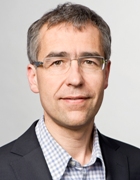
Prof. Dr.-Ing. Stephan Pauleit
Academic Career and Research Areas
The work of the Chair of Prof. Pauleit (b. 1960) involves research, policy advice and lecturing in the field of planning and sustainable development of natural and rural landscapes (incl. urban landscapes). He primarily investigates how planning can meet the future challenges of globalization, such as food security, energy supply shortages, urbanization, adapting to climate change and natural hazards. He is particularly interested in urban ecology and urban land use planning. In recent years, Prof. Pauleit has increasingly turned his focus to how cities can adapt to climate change.
Prof. Pauleit studied landscape planning and landscape architecture at TUM and did his doctorate at the Chair of Landscape Ecology (1989). He worked at the University of Manchester and was a professor at the University of Copenhagen before returning to TUM in 2009. He is Honorary Senior Research Fellow at the University of Manchester and Chairman of the landscape ecology society Freunde der Landschaftsökologie Weihenstephan e.V.
Key Publications (all publications)
Rahman M.A., Franceschi E., Pattnaik N., Moser-Reischl A., Hartmann C., Paeth H., Pretzsch H., Rötzer T., Pauleit S., 2022. Spatial and temporal changes of outdoor thermal stress: influence of urban land cover types. Scientific Reports 12: 671.
AbstractPauleit S., Zölch T., Erlwein S., Reischl A., Rahman M., Pretzsch H., Rötzer T., 2022. Urban green infrastructures for climate change adaptation: a multiscale approach. In. Costanzo V., Evola G., Marletta L. (Eds.). Urban Heat Stress and Mitigation Solutions. An Engineering Perspectives. Routledge, Oxon and New York, pp. 301-322.
AbstractBreuste J., Pauleit S., Haase D., Sauerwein M., 2021. Urban Ecosystems. Function, Management and Development. Springer Verlag, Heidelberg, 331pp.
AbstractPauleit S., Hansen R., Rall E.L., Rolf, W., 2020. Urban green infrastructure: strategic planning of urban green and blue for multiple benefits. In. Douglas I., Anderson P.M.L., Goode D., Houck M.C., Maddox D., Nagendra H., Puay Yok T. (Eds.) The Routledge Handbook of Urban Ecology, 2nd ed., Routledge, London, pp. 931-941.
AbstractPauleit S., Zölch T., Hansen R., Randrup T.B., Konijnendijk van den Bosch C., 2017. Nature-Based Solutions and Climate Change – Four Shades of Green. In. Kabisch N., Korn H., Stadler J., Bonn A. (eds.) Nature‐based Solutions to Climate Change Adaptation in Urban Areas. Linkages between Science, Policy and Practice. Springer Nature Verlag, Cham, pp. 29-50.
AbstractIf you wish your profile to be changed or updated please contact Franz Langer.